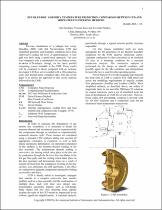 ResearchSpace
ResearchSpace
Detailed disc assembly temperature prediction: comparison between CFD and simplified engineering methods
JavaScript is disabled for your browser. Some features of this site may not work without it.
- ResearchSpace
- →
- Research Publications/Outputs
- →
- Conference Publications
- →
- View Item
| dc.contributor.author |
Snedden, Glen C

|
|
| dc.contributor.author |
Roos, TH

|
|
| dc.contributor.author |
Naidoo, Kavendra

|
|
| dc.date.accessioned | 2007-08-02T09:47:35Z | |
| dc.date.available | 2007-08-02T09:47:35Z | |
| dc.date.issued | 2003-09 | |
| dc.identifier.citation | Snedden, GC, Roos, TH and Naidoo, K. 2003. Detailed disc assembly temperature prediction: comparison between CFD and simplified engineering methods. 17th International Symposium for Air-breathing Engines, Germany, Munich, 5-9 September, 2005, pp 11 | en |
| dc.identifier.uri | http://hdl.handle.net/10204/1063 | |
| dc.description.abstract | Previous simulations of a turbojet disc cavity with full Navier-Stokes CFD and simplified geometry and boundary conditions have been improved to reduce the level of approximation. A new grid was built using a multi-block approach. The case was computed with a commercial Navier-Stokes solver, STAR-CD (CD-Adapco Group), on the latest parallel computing system available at the CSIR. The results are compared to those computed with an in-house developed 1-D flow solver coupled with a 3D conduction code, and thermal paint validation data. The aim of the paper is to review the approach to disc cavity analysis followed by the CSIR | en |
| dc.language.iso | en | en |
| dc.subject | Computer aided drawing | en |
| dc.subject | Finite element method | en |
| dc.subject | DCOOL | en |
| dc.subject | Computation fluid dynamics | en |
| dc.subject | FEM | en |
| dc.subject | CFD | en |
| dc.title | Detailed disc assembly temperature prediction: comparison between CFD and simplified engineering methods | en |
| dc.type | Conference Presentation | en |
| dc.identifier.apacitation | Snedden, G. C., Roos, T., & Naidoo, K. (2003). Detailed disc assembly temperature prediction: comparison between CFD and simplified engineering methods. http://hdl.handle.net/10204/1063 | en_ZA |
| dc.identifier.chicagocitation | Snedden, Glen C, TH Roos, and Kavendra Naidoo. "Detailed disc assembly temperature prediction: comparison between CFD and simplified engineering methods." (2003): http://hdl.handle.net/10204/1063 | en_ZA |
| dc.identifier.vancouvercitation | Snedden GC, Roos T, Naidoo K, Detailed disc assembly temperature prediction: comparison between CFD and simplified engineering methods; 2003. http://hdl.handle.net/10204/1063 . | en_ZA |
| dc.identifier.ris | TY - Conference Presentation AU - Snedden, Glen C AU - Roos, TH AU - Naidoo, Kavendra AB - Previous simulations of a turbojet disc cavity with full Navier-Stokes CFD and simplified geometry and boundary conditions have been improved to reduce the level of approximation. A new grid was built using a multi-block approach. The case was computed with a commercial Navier-Stokes solver, STAR-CD (CD-Adapco Group), on the latest parallel computing system available at the CSIR. The results are compared to those computed with an in-house developed 1-D flow solver coupled with a 3D conduction code, and thermal paint validation data. The aim of the paper is to review the approach to disc cavity analysis followed by the CSIR DA - 2003-09 DB - ResearchSpace DP - CSIR KW - Computer aided drawing KW - Finite element method KW - DCOOL KW - Computation fluid dynamics KW - FEM KW - CFD LK - https://researchspace.csir.co.za PY - 2003 T1 - Detailed disc assembly temperature prediction: comparison between CFD and simplified engineering methods TI - Detailed disc assembly temperature prediction: comparison between CFD and simplified engineering methods UR - http://hdl.handle.net/10204/1063 ER - | en_ZA |





